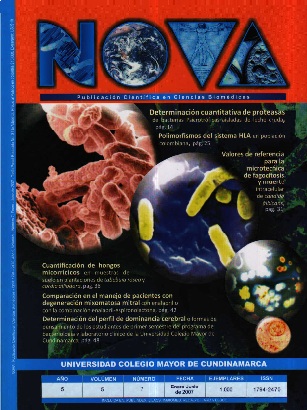NOVA por http://www.unicolmayor.edu.co/publicaciones/index.php/nova se distribuye bajo una licencia Reconocimiento No Comercial- Compartir igual
Así mismo, los autores mantienen sus derechos de propiedad intelectual sobre los artículos,
Declaración de privacidad.
Los nombres y las direcciones de correo electrónico introducidos en esta revista se usarán exclusivamente para los fines establecidos en ella y no se proporcionarán a terceros o para su uso con otros fines.
Quantitative Determination of Proteases of Isolated Psychotropic Bacteria in Raw Milk
The strains were cultured in milk broth 11% for kinetics profile and the experimental data was adjusted to the Baranyi Model. This Model guaranteed a suitable description of _máx, td y Log UFC. Pseudomonas putida R20 showed the best growing profile with _máx = 0,1066h-1 and td = 6,5023h. Proteolytic activity was determined according to Hübner and it was established that Bacillus circulans R5, in a temperature of 5ºC, produced at the 4th fermentation hour the largest amount of proteases (3,618UP/mL) with the rest of the used strains. Finally, it was established that the temperature with the largest proteolytic activity was 5ºC and, as it increases, it causes a considerable decrease in protease production.









